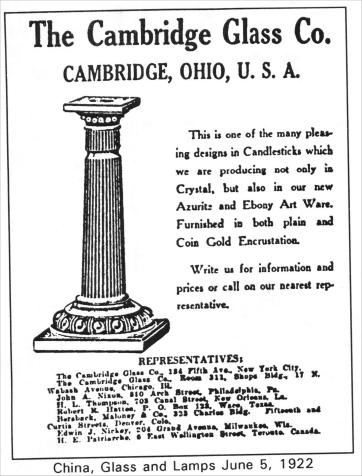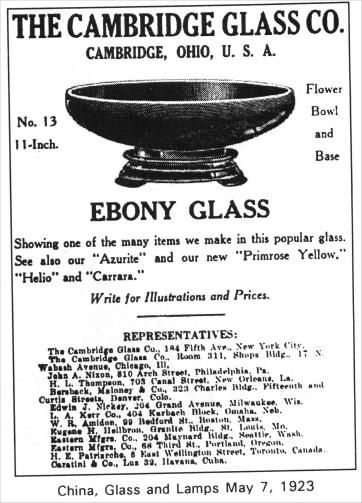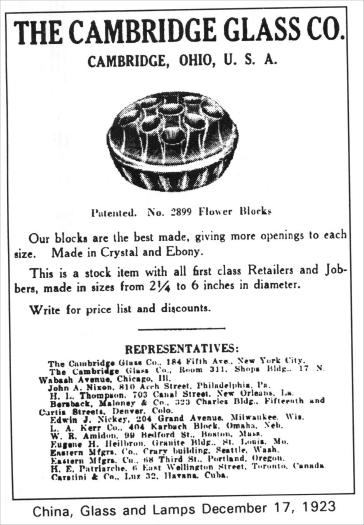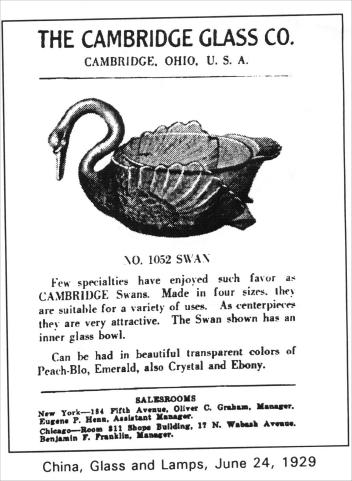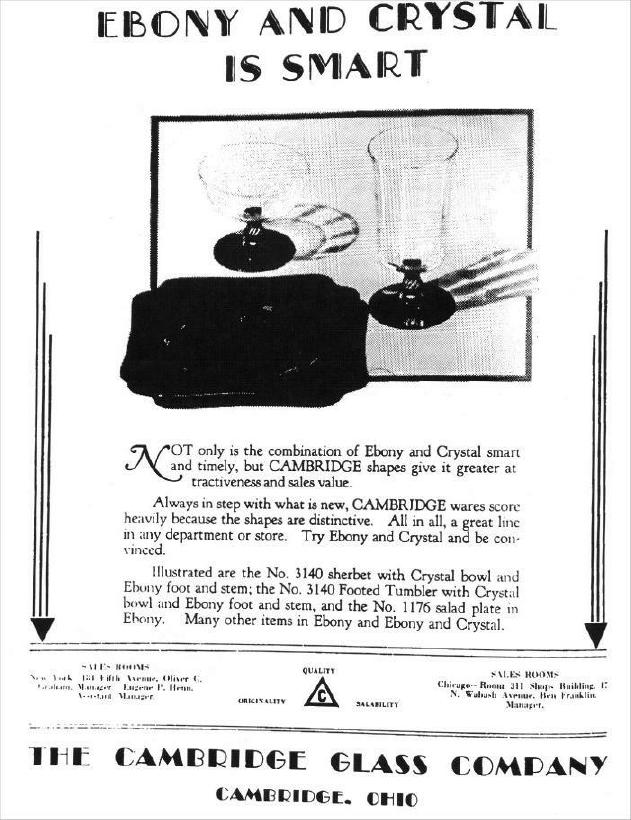Ebony - Part I
by Mark A. Nye
Issue No. 249 - January 1994
Cambridge first made black glass or Ebony, as they named it, in 1916. Produced for several years and then discontinued, Ebony was, in 1922, reintroduced as new. According to Colors in Cambridge Glass the 1922 Ebony "is a sparkling black of very high density that will show deep amethyst, red or shades of brown when held to a strong light."
The following paragraph is from a trade journal report describing the exhibits at the 1922 Pittsburgh Exhibition.
"Another new line from this factory [Cambridge Glass Co.] is called the 'Ebony.' It is a very black and represents an achievement in this class of glassware. Both new colors come in complete tableware lines, including vases, candlesticks, bowls, candy-jars, compotes and cheese and cracker plates." CGL 1/23/22 [Azurite was the other new color.]
Quoting from the June 12, 1922, "New York Trade Notes," a regular CGL feature column:
"The Cambridge Glass Co., of Cambridge, O., are showing at their New York office, 184 Fifth Avenue, a very high grade line of ebony glassware, made in vases, candlesticks, bowls and baskets. A portion of this line comes in gold encrustations."
Unfortunately, trade journal reports frequently dealt in generalities and were usually short on specifics. This is the case here with the reports about the 1922 Cambridge line. The trade journals of the day provided little information about what portion of the line came with gold encrustations. Also, there is little indication in the reports about what etchings formed the basis for the encrustations.
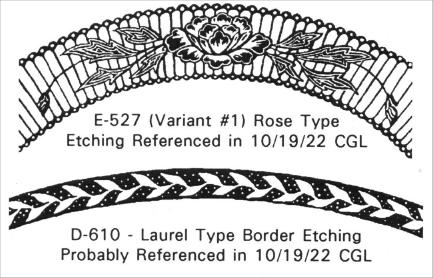 The following, from the October 19, 1922, issue of Crockery and
Glass Journal, does give us some idea of the decorations used:
The following, from the October 19, 1922, issue of Crockery and
Glass Journal, does give us some idea of the decorations used:
"Forming a delightful contrast in coloring, the newest items in fancy glassware are displayed at the salesroom of the Cambridge Glass Co., 184 Fifth Avenue, in charge of Alex G. Menzies and include a full line of fancies in ebony glass richly decorated with gold encrustations. One decoration consists of a 1/4-inch border in finely executed laurel wreath treatment and gold edge band and foot. In another decoration a 1-inch border encrustation effectively employs a conventional rose design in combination with the gold edge band. The shapes are artistic and graceful and the items embrace all the popular articles in fancies, such as candlesticks, fruit and flower bowls, high foot comports, vases and cheese and cracker sets."
Sometime after the 1922 introduction of Ebony and Azurite, Cambridge issued five catalog pages. Done as supplements to the company's Catalog No. 10, each page carried the caption "Special Articles Made in Azurite, Ebony and Crystal for Cutting See Special Price List." Illustrated on the five pages are several bowls, compotes, vases, candlesticks, baskets, candy-jars, and a cheese and cracker plate. Not mentioned in the trade journal reports of the new lines, but illustrated on the catalog pages, were seven, eight, nine and eleven inch plates, creamers and sugars, a covered jug, and jugs without covers.
Identification of Cambridge Ebony pieces, plain and gold encrusted from the early 1920s, is sometimes made based on recognized Cambridge shapes. Much of the etching work done by Cambridge in the early 1920s was limited to borders. There is currently little information available to researchers regarding Cambridge etchings from this period. Thus, some border type etchings can go unidentified as being of Cambridge origin. By late 1922, Cambridge had begun use of the Triangle C trademark in advertising and on glass. However, many older molds did not have the trademark and pieces continued to be made without the Triangle C.
Seldom does a collector come across a piece of etched Ebony from this period, or any other, which is not silver or gold or white gold encrusted. The reason for this is the etching simply does not stand out on such a dark piece of glass and there was little or no demand for such wares.
The December 25, 1922, Cambridge advertisement in CGL read in part:
"The sensations of the 1922 Exhibit were the new 'AZURITE' and 'EBONY' lines of the Cambridge Glass Co. These wares have enjoyed great success and new items and decorative patterns have been added until the lines have no peers in colored glass." None of the Cambridge advertisements appearing in the following weeks or reports of the Pittsburgh Exhibit provided any specifics regarding the new items and decorative patterns.
Emily Tremain, the writer of "New York Trade Notes," had this to say in her column dated June 11, 1923.
"The Cambridge Glass Co ... have done a beautiful and happily consistent thing in a new line of glass salad plates. In the opaque glass there are 'Helio', 'Azurite', 'Ebony' and 'Primrose Yellow' with various gold decorations as well as without. The most attractive thing in that immense show room is the new salad server and its companion, the cracker and cheese plate. They may be had to match any style of the salad plates spoken about above ...
"In this opaque glass in the same colors and designs are cologne bottles in all sizes. The shapes are excellent ... "
Again, tantalizing bits of information but no specifics are provided.
Finally, from the January 7, 1924, issue of CGL comes information regarding a specific decoration. A report covering the 1924 Pittsburgh Show Cambridge exhibit was illustrated. Included in the illustration are a tall comport and candlestick. The report had these comments about those two items.
"The comport and candlestick in stippled effect are strikingly beautiful wares. The background is ebony glass--thin blown. The comport is stippled in silver with silver
edges around the base and flare of the bowl. The candlestick is ebony stippled in gold.
Rather startling is the effect, but it is attractive and rich looking."
Contrary to what the report states, the comport in the illustration is not a thin blown comport. It appears to be a standard comport, one that is frequently seen in the opaque colors. The candlestick is one of the unusual blown shapes. Unfortunately, the available copy is not suitable for reprinting.
The following week a reporter wrote these words about a part of the Cambridge exhibit:
"...Especially good was a line of black glass with gold encrusted fleur de lis design in wide bands, and some black vases with encrusted gold borders an inch and a half wide."
 By
January 1925, little mention of Ebony was occurring in the trade
journals, suggesting that it was no longer a featured line. Cambridge
continued to produce Ebony as occasional references to black bases and
trays are found. Absent, however, from the trade journals and Cambridge
advertising during the next several years were references to an Ebony
Line.
By
January 1925, little mention of Ebony was occurring in the trade
journals, suggesting that it was no longer a featured line. Cambridge
continued to produce Ebony as occasional references to black bases and
trays are found. Absent, however, from the trade journals and Cambridge
advertising during the next several years were references to an Ebony
Line.
The September 1929 issue of CGL contained a full page Cambridge advertisement. It contained illustrations of No. 3120 stemware etched 733, No. 1240 console bowl, No. 638 three light candle holders and the No. 880/881 Bridge Set etched Golf Scene. Part of the caption read:
"Glassware Specialties for the Holidays. Hundreds in the Cambridge Line. We illustrate only a few of the many items in the Cambridge line in transparent colors of Peach Blo, Emerald, Willow Blue, Gold Krystol, Black and Amber-Glo."
Note the use of the capitalized name Black instead of the usual name Ebony. A similar advertisement with the same text, but featuring different items, appeared in the October issue. Pictured in that advertisement are No. 3130 stemware etched 740, the 1160/1161 five-piece relish set, Modernistic, and the 1020/1021 seven-piece cocktail shaker set, etched 731. It is doubtful the stemware in the two advertisements was produced in Ebony and then etched. However, I have seen an etched Ebony No. 1240 console bowl and a No. 1020 cocktail shaker. It appears there is little or no significance to the absence of the Ebony name in the previous two advertisements.
Another full page Cambridge advertisement appeared in the November 1929 issue. Several of the advertisements referred to in the text above are shown below.
To Be Continued Next Month ...
